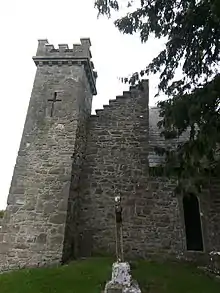Tea Lane Graveyard
Tea Lane Graveyard (Irish: Reilig Lána an Tae) is a Christian cemetery located in Celbridge, Ireland.[1][2][3][4]
 Conolly chapel | |
 Location in Ireland | |
| Details | |
|---|---|
| Established | 7th century AD |
| Location | Church Road, Celbridge, County Kildare |
| Country | Republic of Ireland |
| Coordinates | 53.338772°N 6.546788°W |
| Type | Christian |
| Style | Rural cemetery |
| Owned by | Glasnevin Trust |
| Size | 3,140 m2 (0.775 acre) |
| No. of graves | thousands |
| Website | tealanegraveyard |
| Find a Grave | Tea Lane Graveyard |
History
The site is located 500 m northwest of the River Liffey and is the reputed burial site of Saint Mochua of Timahoe (died 657). Mochua built a wooden church on the site and was the first abbot of Clondalkin. It stood on the Slighe Mhor, an ancient roadway which ran from Dublin to Galway.[5]
The Normans handed over control of St Mochua's church to the Abbey Church of Saint Thomas the Martyr, Dublin in 1215; the abbey supplied Celbridge with its priests. After the Dissolution of the Monasteries the abbey was suppressed and came into the possession of the Anglican Church of Ireland.[6]
The present church building was built c. 1860, incorporating material from the medieval church (c. 1600).[7]
The placename dates to the 19th century, when many English workers were brought over to work at Celbridge mill; the locals noted the large amounts of tea they drank, and the tealeaves that they threw into the roadway,[8] and Church Lane was nicknamed "Tea Lane."[9]
Gallery
 Mortuary chapel
Mortuary chapel Ruined medieval church, with tracery fragment visible in the windowframe
Ruined medieval church, with tracery fragment visible in the windowframe
Notable burials

- Katherine Conolly (1662–1752), wife of William Conolly
- Lady Louisa Conolly (1743–1821), one of the famous Lennox Sisters
- William Conolly (1662–1729), Speaker of the Irish House of Commons and builder of Castletown House
- Many of the Dongan family[10]
- Henry Grattan (junior) (1789–1859), Whig Member of Parliament
- Vol. Michael Heffernan (1889–1954); member of the Irish Volunteers and Irish Republican Army and fought in the 1916 Easter Rising, Irish War of Independence and Irish Civil War (on the anti-Treaty side)[11][12]
- Saint Mochua of Timahoe (d. 657)[13]
- Air Mechanic, Second Class C.J. Sheridan, Royal Air Force (1900–1921); the only World War soldier in Tea Lane[14]
References
- "Tea Lane Graveyard Conservation Project". www.facebook.com.
- "History morning at Celbridge's Tea Lane graveyard".
- McCarthy, Patricia (12 July 2017). Life in the Country House in Georgian Ireland. Paul Mellon Centre for Studies in British Art. ISBN 9780300218862 – via Google Books.
- D'Arcy, Fergus A. (1 January 2007). Remembering the War Dead: British Commonwealth and International War Graves in Ireland Since 1914. Stationery Office. ISBN 9780755775897 – via Google Books.
- "New conservation project for Tea Lane graveyard in Celbridge – Kildare Local History . ie". kildarelocalhistory.ie.
- Doohan, Tony (1984). A History of Celbridge. Genprint Ltd, Dublin. pp. 8, 71–72.
- "Tea Lane Graveyard, Church Road, Celbridge, County Kildare". www.buildingsofireland.ie.
- O'Dowd, Desmond J. (1 October 1997). Changing times: the story of religion in 19th century Celbridge. Irish Academic Press. ISBN 9780716526353 – via Google Books.
- "Celbridge History by Charles Graham (1896)". 5 February 2013.
- Higgins, Aidan (12 July 1995). Donkey's years: memories of a life as story told. Secker & Warburg – via Internet Archive.
tea lane.
- "Tea Lane Graveyard Conservation Project". www.facebook.com.
- "Sinn Fein lay wreath at Heffernan memorial in Kildare".
- http://www.heritageweek.ie/whats-on/event/ghosts-of-tea-lane-graveyard
- http://www.cwgc.org/find-war-dead/casualty/662844/SHERIDAN,%20C%20J